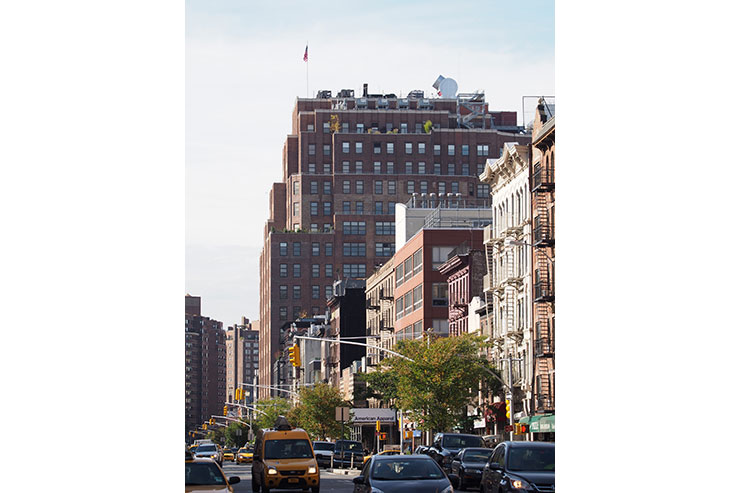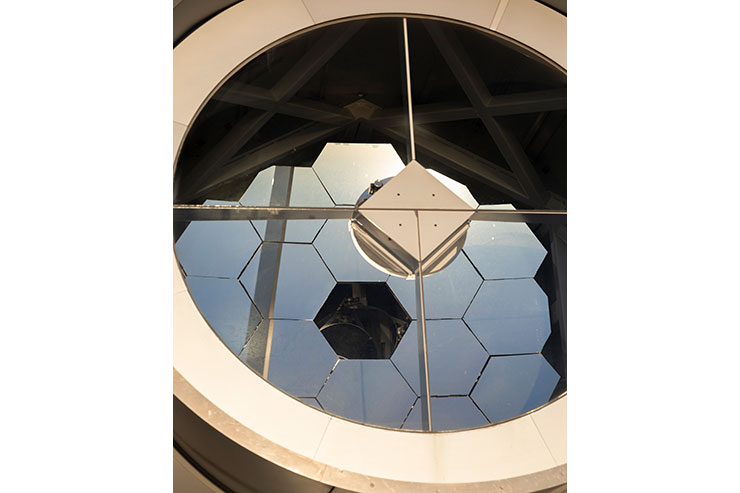This website uses cookies so that we can provide you with the best user experience possible. Cookie information is stored in your browser and performs functions such as recognising you when you return to our website and helping our team to understand which sections of the website you find most interesting and useful.
Lightfall, USA
ProjectLightfallLocationNew York, USALighting DesignLoisos + Ubbelohde and Lumen Architecture, USAArtistLoisos + UbbelohdeArchitectHLW, USAAdditional DesignTelescope Controls: Starman Systems | Structural Engineer: Mar Structural Design | Optical Design & Fabrication: Optical Mechanics | Primary Mirrors Fabrication: Displays and Optical TechnologiesClientJLLLighting SuppliersLight Dagger is a completely custom daylight sculpture with no electric lighting, Feelux
111 Eighth Ave is a large building, one of the largest in Manhattan, occupying a full city block.
The building, commissioned by the Port Authority and designed by Lusby Simpson, was conceived as a vertically integrated manufacturing, shipping and office building, and completed in 1932 during the Depression. Now the building sits on top of the ninth avenue “fiber highway”, strategically located to be one of the most connected buildings in the world. It houses many well-known internet and technology companies, as well as other tenants, such as a hospital, retail and financial institutions. The building has been undergoing a process of modernization of its infrastructure, building skin and systems. As part of that a new exit stair, Stair J, was designed to comply with modern exiting requirements. Stair J occupies one of four shafts that used to house massive elevators rated at 100,000 pounds, capable of lifting an entire delivery truck as far as 15 stories. As all these elevators are not needed now, three of four shafts have been retrofitted for other uses. One of these is Stair J.
This building, like our modern society, depends on optical communication, the transmission of information through optical means. The principle was first demonstrated in 1880 with a device that transmitted voice signals over an optical beam. It was very efficient, but subject to the vagaries of the atmosphere and thus impractical. Fiber optics, developed much later, allows one to send light in a cable by total internal reflection, giving us great facility to communicate a lot of information very fast within a very small diameter. Our sculpture, Light Fall, uses the same principle, but rather than propagate human communication it brings information about the sky to the occupants of the building. The sculpture does this by looking directly at the sun, concentrating the luminous energy into a beam, and sending it to the Light Dagger. The Light Dagger then takes a little bit of that light at each floor and pipes it through glass fibers that shine along their length and sparkle at their ends. The light changes in both intensity and color throughout the day based on sun position and sky conditions.
The roof at 111 8th Avenue has an excellent view of the sky. Nearly every solar position can be seen by the Light Cannon. The two parts of the city that are vertically prominent, Battery Park and Midtown, do not block the path of the sun appreciably. Unless a new tall building is built that covers part of the sun path, the only factor that will affect the operation of the light sculpture will be weather.
The solar sculpture consists of three distinct parts: the Light Cannon, the Redirecting Optics, and the Light Dagger. The Light Cannon is located on the roof. It is a custom built optical machine that rotates in two axes and follows the path of the sun. It collects, filters, and concentrates sunlight. The light is then funneled into a light pipe that sends the light into the Redirecting Optics.
The Redirecting Optics consist of a series of mirrors and lenses that provide a pathway for the light to travel from the Light Cannon, around the mechanical equipment on the 16th and 17th floors, and into the top of stairwell, terminating on a truss suspended above the Light Dagger. A second set of optics inhabiting the same light shaft provides the real time white light image of the solar disc on the ceiling of the stair.
The Light Dagger, runs vertically through the center of the stair, and is made of thousands of individual glass fibers grouped and sheathed with layers of translucent silicone. The sheathed fibers transmit sunlight along their length, with their brightest points being at their ends.
The Light Cannon traces the sun by movement on two axes, filters out infrared and ultraviolet wavelengths, collects and redirects visible solar radiation through the shaft below. The sun is a powerful source of radiation. A mere fifteen times the unfiltered maximum intensity of the sun is enough to make lumber spontaneously burst into flames. We need to concentrate the solar radiation to ensure that the sculpture shines, but do so in a safe manner. Our first control is the initial glass through which the solar flux is transmitted in the assembly on the roof. This glass features a special coating to filter out about half of the invisible radiation, which is about half of the total solar energy. This effectively concentrates the available solar radiation to a six-sun intensity, without the infrared and most of the ultraviolet. Below the glass is an extreme short focus cassegrain composite mirror telescope that tracks the sun with a computer controlled motor drive system. Its primary mirror directs the sun to a set of coude mirrors. These mirrors, without the use of any additional controls, redirect the light to a vertical column.
The solar imager is a solar projector designed to project a real time image of the solar disc on the ceiling of the stairwell. The image of the sun will vary from clear to occluded by clouds and atmospheric haze. In this way, the real time projection 80 feet below the roof, increases connection to the world outside for the occupants.
From the redirecting optics that are mounted on the truss at the top of the stairwell, light enters the dagger as a 24” beam of light. The top of the Light Dagger is made of a ring with an inside diameter of 24” to receive this beam. At each ring, the outer area of the beam is directed into the end of a ring of fibers. Glass redirecting tubes focus the light onto the fused common ends of the glass fibers. From there the light continues down through the bundled fibers, emitting light to the sides of the fibers. At the bottom of each fiber is a brighter spot of light as the remaining light emits the end of the glass fiber.










